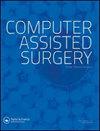基于GPU加速的软组织热损伤建模
IF 1.9
4区 医学
Q3 SURGERY
引用次数: 5
摘要
热疗治疗需要精确控制热能,形成足以覆盖肿瘤而不影响周围健康组织的凝血区。这使得软组织热损伤的建模在热疗治疗中变得重要,以完全根除肿瘤而不引起周围健康组织的组织损伤。本文提出了一种基于GPU加速的生物热传导及相关热致组织损伤建模与分析方法,用于热消融中软组织损伤的预测,这是一种典型的热疗治疗。该方法将Arrhenius Burn理论与Pennes的生物传热理论相结合,用于预测软组织的温度场和热损伤。用伽辽金有限元法在三维线性四面体网格上进行空间离散,用显式正演有限差分法在时间上进行离散。为了解决有限元方法中涉及的昂贵的计算负载,GPU加速使用高级着色器语言实现,并通过GPU渲染管道中计算着色器的顺序执行来实现。通过对一个立方体试件的仿真和与独立CPU运行的对比分析,验证了所提出的gpu加速有限元方法可以有效地实时预测温度分布和相关的热损伤。结果表明,温度峰值出现在热源点,温度变化主要集中在热源附近。还发现,通过持续施加点源热能,热源处的组织在几秒钟内迅速坏死,而整个邻近组织在几分钟内完全坏死。此外,所提出的GPU加速显著提高了软组织热损伤预测的计算性能,与独立CPU执行相比,计算时间最多减少了55.3倍。本文章由计算机程序翻译,如有差异,请以英文原文为准。
Modeling of soft tissue thermal damage based on GPU acceleration
Abstract Hyperthermia treatments require precise control of thermal energy to form the coagulation zones which sufficiently cover the tumor without affecting surrounding healthy tissues. This has led modeling of soft tissue thermal damage to become important in hyperthermia treatments to completely eradicate tumors without inducing tissue damage to surrounding healthy tissues. This paper presents a methodology based on GPU acceleration for modeling and analysis of bio-heat conduction and associated thermal-induced tissue damage for prediction of soft tissue damage in thermal ablation, which is a typical hyperthermia therapy. The proposed methodology combines the Arrhenius Burn integration with Pennes’ bio-heat transfer for prediction of temperature field and thermal damage in soft tissues. The problem domain is spatially discretized on 3-D linear tetrahedral meshes by the Galerkin finite element method and temporally discretized by the explicit forward finite difference method. To address the expensive computation load involved in the finite element method, GPU acceleration is implemented using the High-Level Shader Language and achieved via a sequential execution of compute shaders in the GPU rendering pipeline. Simulations on a cube-shape specimen and comparison analysis with standalone CPU execution were conducted, demonstrating the proposed GPU-accelerated finite element method can effectively predict the temperature distribution and associated thermal damage in real time. Results show that the peak temperature is achieved at the heat source point and the variation of temperature is mainly dominated in its direct neighbourhood. It is also found that by the continuous application of point-source heat energy, the tissue at the heat source point is quickly necrotized in a matter of seconds, while the entire neighbouring tissues are fully necrotized in several minutes. Further, the proposed GPU acceleration significantly improves the computational performance for soft tissue thermal damage prediction, leading to a maximum reduction of 55.3 times in computation time comparing to standalone CPU execution.
求助全文
通过发布文献求助,成功后即可免费获取论文全文。
去求助
来源期刊

Computer Assisted Surgery
Medicine-Surgery
CiteScore
2.30
自引率
0.00%
发文量
13
审稿时长
10 weeks
期刊介绍:
omputer Assisted Surgery aims to improve patient care by advancing the utilization of computers during treatment; to evaluate the benefits and risks associated with the integration of advanced digital technologies into surgical practice; to disseminate clinical and basic research relevant to stereotactic surgery, minimal access surgery, endoscopy, and surgical robotics; to encourage interdisciplinary collaboration between engineers and physicians in developing new concepts and applications; to educate clinicians about the principles and techniques of computer assisted surgery and therapeutics; and to serve the international scientific community as a medium for the transfer of new information relating to theory, research, and practice in biomedical imaging and the surgical specialties.
The scope of Computer Assisted Surgery encompasses all fields within surgery, as well as biomedical imaging and instrumentation, and digital technology employed as an adjunct to imaging in diagnosis, therapeutics, and surgery. Topics featured include frameless as well as conventional stereotactic procedures, surgery guided by intraoperative ultrasound or magnetic resonance imaging, image guided focused irradiation, robotic surgery, and any therapeutic interventions performed with the use of digital imaging technology.
 求助内容:
求助内容: 应助结果提醒方式:
应助结果提醒方式:


